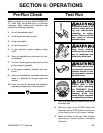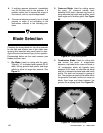
G5959/G9957 12" Table Saw -27-
Figure 34. Plywood blade.
4. Plywood Blade: Used for cutting plywood or
veneers. A 12" plywood blade will have 60-
80 teeth, a steep alternate top bevel tooth
profile and very shallow gullet. See Figure
34.
5. Thin-kerf: Most types of saw blades are
available in a thin-kerf style. Used primarily
to minimize stock wastage. It is recommend-
ed thin-kerf blades be used in conjunction
with a blade stabilizer to reduce blade wob-
ble. Note: Most blade guards/splitters are
thicker than most thin-kerf blades. Make
sure the stock will pass by the guard/splitter
before beginning a cut.
6. Dado Blades: There are two types of dado
blades: stack and wobble. Stack dadoes are
expensive and time consuming to set up but
leave a clean and smooth finish. Stack
dadoes are used for fine furniture and cabi-
net making. Wobble dadoes are inexpensive
and easy to set up, but leave a rough finish.
7. Moulding Heads: A moulding head is a cut-
terhead that attaches to the arbor and holds
individual moulding knives. We do not rec-
ommend their use. They are very dangerous
and require training beyond the scope of this
manual.
This section on blade selection is by no means
comprehensive. Always follow the saw blade
manufacturer's recommendations to assure safe
and efficient operation of your table saw.
Figure 35. Various saw tooth cutting profiles.
Flat
Top
Blade
Alternate
Top
Bevel
Alternate
Top Bevel
And
Raker
Triple
Chip
Blade
Crosscutting
Crosscutting means cutting across the grain of
the wood. In wood products without grain (i.e.
MDF, particleboard) it simply means cutting
across the width of the stock.
Crosscuts are made with the miter gauge. There
are two miter gauge slots in the table top. Use the
one that works best for the piece being crosscut.
To make a crosscut using the miter gauge:
1. Inspect the board for soundness. You do not
necessarily need a square edge to crosscut
with accuracy.
2. Inspect the miter gauge. Is it properly set and
tight? Move the rip fence completely out of
the way.
3. Turn on the saw and allow it to come to full
speed.
4. Hold the workpiece firmly against the face of
the miter gauge and ease it into the blade as
shown in Figure 36.
5. Turn off the saw and allow the blade to come
to a full stop.


















